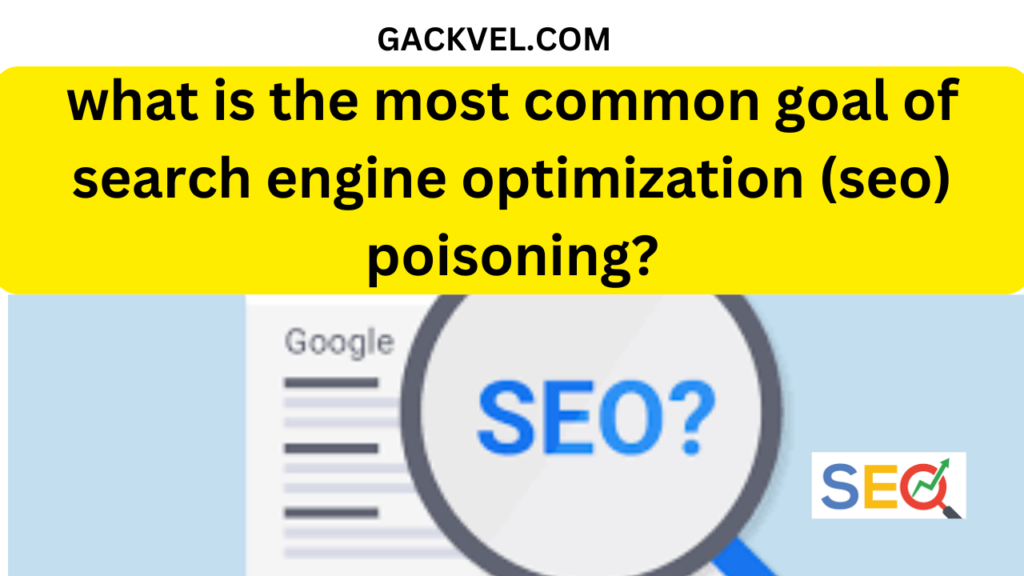Search Engine Optimization (SEO poisoning) poisoning, also known as black-hat SEO, aims to manipulate search engine algorithms for malicious purposes. The most common goal is to drive traffic to harmful websites.

Here’s a detailed explanation and an image to illustrate the concept:
Goal: Misdirect Users to Malicious Sites
- Deception: Attackers create fake web pages optimized with popular keywords to rank high in search results.
- Luring Users: Unsuspecting users searching for legitimate information click on these deceptive links.
- Malicious Content: The websites might contain malware that infects user devices, steal personal information, or attempt phishing scams.
Top 10 Affiliate program Earn 100 $
Here’s how SEO poisoning works:
- Keyword Targeting: Attackers identify keywords with high search volume but may not be directly related to their malicious intent. For instance, they might target a general term like “free software download” to attract users searching for legitimate software.
- Content Camouflage: The fake web pages might contain some relevant content alongside hidden malicious code or misleading information.
- Black-Hat SEO Techniques: Attackers employ various unethical tactics to inflate a website’s ranking, including keyword stuffing (excessive keyword use), cloaking (showing different content to search engines vs. users), and buying backlinks from low-quality websites.
Impact of SEO Poisoning:
- Endangers Users: Malware can steal data, corrupt files, or disrupt computer operations. Phishing scams can trick users into revealing sensitive information like passwords or credit card details.
- Erodes Trust: When users encounter malicious websites disguised as legitimate ones, it undermines trust in search results overall.
- Unethical Competition: Black-hat SEO tactics create an unfair advantage for malicious websites, harming legitimate businesses that rely on organic search traffic.
How to Avoid SEO Poisoning:
- Search with Caution: Be wary of websites that rank high but have poor design, unclear information, or generic content.
- Look for Trust Signals: Check for established brand names, secure connections (HTTPS), and positive user reviews.
- Verify Information: Cross-check information from other reliable sources before making any downloads or entering personal data.
By understanding SEO poisoning and practising safe searching habits, you can protect yourself from online threats.
SEO Poisoning FAQ: Malicious Intent in Search Results
What is SEO poisoning?
SEO poisoning, also known as black-hat SEO, is the manipulation of search engine algorithms to make malicious websites rank higher in search results.
What’s the most common goal?
The primary goal is to drive traffic to harmful websites. Attackers lure unsuspecting users with seemingly relevant content, but these websites harbor malicious intent.
How do they achieve this?
- Keyword Targeting: Attackers target popular keywords that might not directly relate to their malicious intent. This attracts users searching for legitimate information.
- Deceptive Content: Fake web pages contain some relevant content alongside hidden malicious code or misleading information.
- Black-Hat SEO Techniques: Unethical tactics like keyword stuffing, cloaking (showing different content to search engines vs. users), and buying low-quality backlinks inflate the website’s ranking.
What are the dangers of SEO poisoning?
- Malware Infection: Malicious websites can infect user devices with malware that steals data, corrupts files, or disrupts computer operations.
- Phishing Scams: Deceptive websites can trick users into revealing sensitive information like passwords or credit card details.
- Eroded Trust: Users encountering malicious websites disguised as legitimate ones lose trust in search results overall.
- Unfair Competition: Black-hat SEO tactics create an unfair advantage for malicious websites, harming legitimate businesses relying on organic search traffic.
How can I protect myself?
- Search with Caution: Be wary of websites that rank high but have poor design, unclear information, or generic content.
- Look for Trust Signals: Check for established brand names, secure connections (HTTPS), and positive user reviews.
- Verify Information: Cross-check information from other reliable sources before making any downloads or entering personal data.
By understanding SEO poisoning and practising safe searching habits, you can protect yourself from online threats.